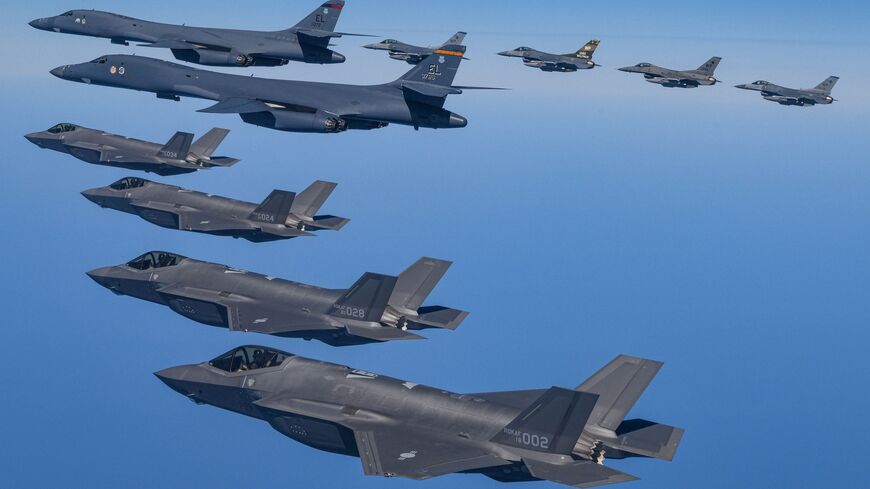Combat aircraft from Israel, Jordan and Saudi Arabia flew alongside US B1 bombers over the Middle East on Thursday in the Pentagon’s latest display of force directed at Iran.
Aircraft from five Middle Eastern militaries linked up with a pair of US Air Force B1-B Lancers as they transited the Persian Gulf region after having been launched from the UK, US military officials said.
The demonstration culminated with the American bombers dropping live munitions at training ranges in Saudi Arabia and Jordan before flying back to base in Spain. The B-1Bs dropped "multiple" air-launched AGM-158A JASSM cruise missiles and 550-pound GBU-38 bombs on “multiple simulated targets” during the mission, a defense official told Al-Monitor.
The Pentagon is withholding the identity of two Middle Eastern countries that took part in the exercise at their request, officials said.
Why it matters: The bomber task force mission came a day after Washington's top diplomat Antony Blinken met with foreign ministers from Gulf Cooperation Council countries in Saudi Arabia amid a broader push by the Biden administration to convince Arab militaries to take a more stand-up role to deterring Iran.
Washington is signalling its intent to remain the premier security guarantor in the Middle East, despite increasing perceptions in Gulf capitals that China can offer new strategic opportunities as US military power is increasingly focused elsewhere.
The Pentagon has periodically sent strategic bombers over the Middle East in recent years in a bid to dissuade attacks by Iran and networks of militias it supports, which US officials say continue to seek to expel American forces from the region.
Arab and Israeli pilots have flown alongside the US bomber task forces since additional Arab governments – so far the UAE, Bahrain and Morocco – began establishing formal ties with Israel in 2021.
Dropping various live munitions on simulated targets in multiple countries marked a new step in those efforts, the deputy commander of US Air Force units in the Middle East, Maj. Gen. Mark Slocum, told Al-Monitor.
"These missions demonstrate the credibility of our forces to address a global security environment that is more diverse and uncertain than at any other time in our history," Slocum said.
"The timing of this is meant to demonstrate we as a team can deliver overwhelming combat power at a moment’s notice," the general added.
The dramatic display came as Blinken visited Saudi Arabia amid Washington's push to convince Crown Prince Mohammed bin Salman to normalize ties with Israel.
The Biden administration has struggled to dispel concerns among Arab leaders that it has been abandoning its defense commitments in the region as the Pentagon diverts military forces to deter Russia and China.
“These bomber missions represent the US’s commitment to our partners,” the top commander of US Air Force units in the Middle East, Lt. Gen. Alexus Grynkewich, said in a statement.
"Together we are operationalizing concepts designed to make us more agile in our execution, more strategic in our deterrence and more resilient in our capability," Grynkewich said.
Pentagon officials have sought to encourage regional militaries to build up their own capabilities with US backing, but there remains reluctance among top officials the region to being seen as part of a US- and Israeli-led bloc oriented against Iran.
In January, US B-52 bombers escorted by Israeli fighter jets dropped live bombs on mock targets in Israel’s Negev Desert during a strategic long-range air exercise which former senior US officials described to Al-Monitor as indicative of the Pentagon’s operational plans to potentially knock out Iran’s nuclear sites.
Senior military officials under the Biden administration have said they hope to include other militaries in the Middle East in similar air exercises.
Know more: The bomber overflight comes as military forces from the US and Gulf Cooperation Council countries are participating in a two-week exercise in Saudi Arabia focused on integrated air and missile defense cooperation.
American defense officials have made strides in convincing Arab counterparts to share air defense data and partake in maritime security patrols in a bid to thwart Iran’s attacks.
But more than two years after Saudi Arabia, the UAE, Bahrain and Egypt formally patched up a hostile dispute with Qatar, trust remains low in the region, inhibiting intelligence sharing and other forms of cooperation which Pentagon officials say is necessary to build an effective bulwark.
The commander of all US forces in the Middle East, US Army Gen. Michael “Erik” Kurilla, discussed ways forward on multinational military cooperation with top regional defense chiefs in Saudi Arabia, Israel, the UAE, Iraq, Qatar, Kuwait and Jordan during a two-week tour of the region last month.
Kurilla also met with Emirati President Mohamed bin Zayed Al Nahyan, Qatari Emir Tamim bin Hamad Al Thani and Iraqi Prime Minister Mohammed Shia al-Sudani during stops in those countries.
What's next: The US and GCC ministers agreed to hold another round of working group meetings focused on integrated air and missile defense and maritime security later this year, according to a State Department readout of today's meeting.
The sides "will also explore the possibility of holding working groups later this year on military preparedness and training and streamlining the transfer of critical defense capabilities," the statement read, in reference to backlogged requests in the region for US arms sales.
Editor's note: This story has been updated since publication to include additional quotations.








